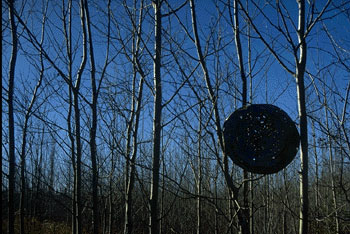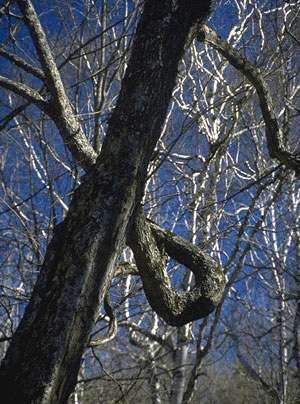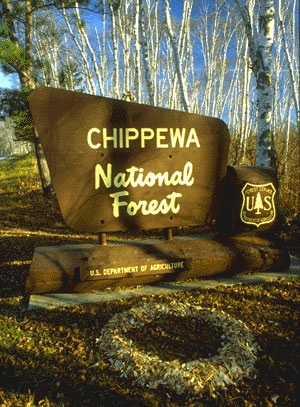MINNESOTA
Superior National Forest

Rainbow Zero. Clearcut's often become
dumping grounds for those who live in the region. At the edge of a road
leading into this clearcut a pile of multi-colored clothes provided the
rainbow colors for this circle which enclosed chips from a Grand Rapids
pulp mill. Minnesota's national forests have been largely cleared of native
forest and replaced with fast growing aspen, an ideal wood for chipping.
Superior National Forest have been managed primarly for logging with recreation
playing a distant second class role. However a USFS 1995 report showed
that by the year 2000, recreation, wildlife and fish will generate over
84% of the forest-generated income and over 87% of forest-generated jobs.
With these statistics in my the North Star Chapter of the Sierra Club has
proposed a management plan that would transistion and return the converted
forests of Superior NF to the natural native cover type (pre-settlement,
pre-logging). This would be the beginning-of-the-end to commercial logging
as we know it in this forest. However, commercial logging may even increase
in the next ten years to achieve the desired future forest conditions.
The USFS is in the midst of developing a new ten-year management plan for
this forest and the North Star Chapter of the Sierra Club is working to
ensure that their plan will be considered.

Zero Aspen Zero. This trash can lid is proped
up for target practice in a stand of aspen trees where native forest once
stood.This zerocircle highlites the Sierra Club's proposed plan to eliminate
these trees and restore the natural forest conditions.

Natural Zero. An older hardwood tree
makes "the sign" in a stand of young aspen. To help the North Star Sierra
Club achive its vision of a restored Superior National Forest contact:
North Star Sierra Club
1313 5th St. SE #324-B
Minneapolis, MN 55414
Ray Fenner at fenner@PioneerPlanet.infi.net
Clyde Hanson at hanso169@tc.umn.edu
Chippewa National Forest

Chippewa Chip Zero. A circle of chips
from a paper mill in Grand Rapids lays in front of the boundary sign along
the southern entrance of the Chippewa National Forest. The Chippewa was
the first National Forest established east of the Mississippi River. It
encompasses 1.6 million acres of which 660,000 are managed by the Chippewa
National forest. It includes 1,300 lakes, 920 miles of streams, 150,000
acres of wetlands and is home to 6 packs of wolves and the largest breeding
population of bald eagles outside of Alaska. But the Chippewa is in trouble.
Fire suppression and short-term financial considerations have resulted
in the conversion of the much of the forest cover to short-rotation aspen
(in background of above photo). This exploitation has left a landscape
that is neither scenic nor natural. According to a 199f4 state studyt,
current logging rates on Minnesota's forests are causing significant declines
in numerous species.
The USFS is developing a new ten-year management plan for the Chippewa.
The current management plan emphasizes logging, mainly by clear-cutting,
which has had devastating impacts on the diversity and abundance of forest-dependent
plant and animal species. The North Star Chapter of the Sierra Club has
developed a management plan alternative which places primary management
emphasis on restoring native biodiversity, creating more natural distribution
of forest age classes (particularly larger blocks of native, old growth
forests), and public use of the national forest primarily for recreational
purposes and non-commercial, individual harvesting of forest products.

Still Lake Zero. Along the quiet shores
of one of the Chippewa's 1,300 lakes I cast this circle of chips from a
Grand Rapids Mill--half in and half out of the still lake waters. Two loons
sang in the distance while the water-borne chips floated a message of wholeness
and restoration of the native Northwoods.

Lost Forty Zero. Believe it or not,
all that is left of Minnesota's native old growth forest in the Chippewa
can be found in a 144 acre segment known as the "Lost Forty." It was not
spared the saw out of any special remorse or consideration but merely by
a mapping error which described the land as part of Coddington Lake. Birch
bark gathered from a downed tree forms this zero between two stately red
pines. The beauty of the Sierra Club's management proposal for the Chippewa
is that it's long term goal is to create old growth forests like this one,
forests that once covered the Chippewa. To help them achieve this goal
contact:
North Star Sierra Club
1313 5th St. SE #324-B
Minneapolis, MN 55414
Ray Fenner at fenner@PioneerPlanet.infi.net
Clyde Hanson at hanso169@tc.umn.edu
GALLERY
HOME





